Native
Pelochrista derelicta (Heinrich) (Tortricidae: Olethreutinae: Eucosmini)
Common name: derelict Pelochrista moth
FWL: 5.5-8.0 mm
Head, thorax pale brown to dark reddish-brown; forewing with ground color similar to scaling on head and thorax with slightly darker basal fasciabasal fascia:
the fascia (transverse band) at the base of the forewing 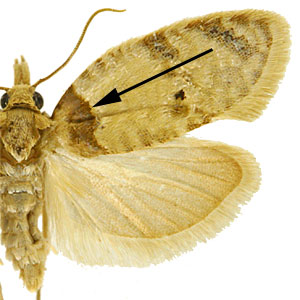 . The most conspicuous and useful feature is the pale distaldistal:
. The most conspicuous and useful feature is the pale distaldistal:
farthest from body, distant from point of attachment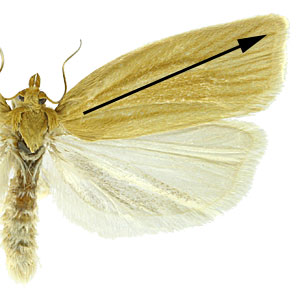 margin of the median fasciafascia:
margin of the median fasciafascia:
a dark transverse band on the forewing 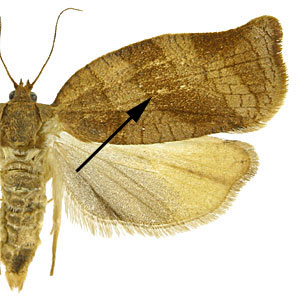 , which contrasts strongly with the much darker basal portion of the forewing. This nearly straight line runs from approximately halfway along the costacosta:
, which contrasts strongly with the much darker basal portion of the forewing. This nearly straight line runs from approximately halfway along the costacosta:
the anterior margin of each wing  to just short of the tornustornus:
to just short of the tornustornus:
the junction of the termen and dorsum of the wing 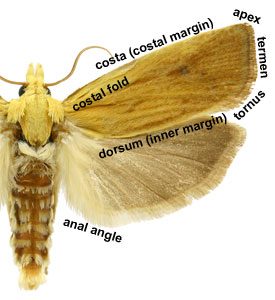 on the inner margininner margin:
on the inner margininner margin:
see dorsum 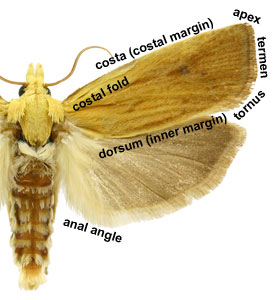 . Beyond this line the forewing is slightly paler and the paired costal strigulaecostal strigulae:
. Beyond this line the forewing is slightly paler and the paired costal strigulaecostal strigulae:
small, usually pale, semirectangular marks along the costa 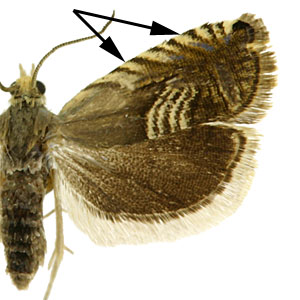 are more evident. The male forewing lacks a costal fold. The hindwing of both sexes is brown.
are more evident. The male forewing lacks a costal fold. The hindwing of both sexes is brown.
Male genitalia are characterized by a weakly-developed uncusuncus:
a sclerotized process which is fused to the posterodorsal margin of tergum IX ; moderate, nub-like sociisocii:
; moderate, nub-like sociisocii:
a pair of lightly sclerotized setose lobes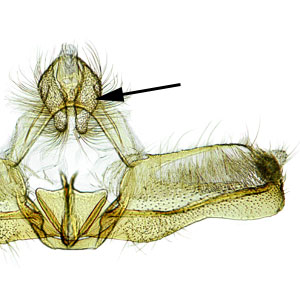 ; and valvaevalvae:
; and valvaevalvae:
plural of "valva" with a narrowly rounded cuculluscucullus:
with a narrowly rounded cuculluscucullus:
the distal portion of the male valva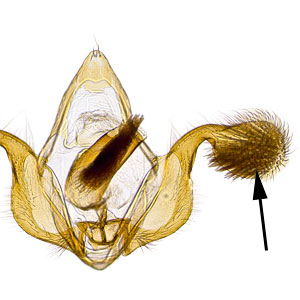 and a sharply produced anal angleanal angle:
and a sharply produced anal angleanal angle:
on the hind wing, the angle nearest the end of the abdomen when the wings are expanded  with a single stout spine. Female genitalia are characterized by a narrow lamella antevaginalis on a plate-like sterigmasterigma:
with a single stout spine. Female genitalia are characterized by a narrow lamella antevaginalis on a plate-like sterigmasterigma:
the sclerotized region surrounding the female ostium bursae  and two signasigna:
and two signasigna:
plural of "signum" in the corpus bursaecorpus bursae:
in the corpus bursaecorpus bursae:
a dilated membranous sac at the anterior end of the bursa copulatrix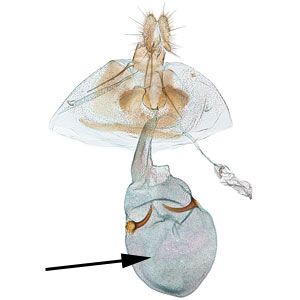 .
.
The following account is summarized from MacKay (1959)MacKay (1959):
MacKay, M. R. 1959. Larvae of the North American Olethreutidae (Lepidoptera). Canadian Entomologist, Supplement 10: 1-338..
Mature larva approximately 13 mm in length; width of head approximately 1.4 mm; head pale except for darker pigmentation laterally and on mandibles; body, legs similarly pale; anal fork absent; SV group on A1, 2, 7, 8, 9 typically 2:2:2:2:2.
Detailed figures of larval chaetotaxychaetotaxy:
the arrangement of setae (in reference to Lepidoptera larvae), often depicted on a "setal map"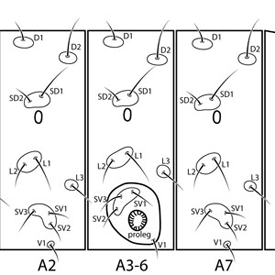 are available in MacKay (1959)MacKay (1959):
are available in MacKay (1959)MacKay (1959):
MacKay, M. R. 1959. Larvae of the North American Olethreutidae (Lepidoptera). Canadian Entomologist, Supplement 10: 1-338..
Well-marked individuals of P. derelicta are unlikely to be confused with any other Nearctic tortricid with the exception of P. juncticiliana. The two can be separated by range: P. derelicta occurs east of the Rocky Mountains and P. juncticiliana to the west. Male genitalia also differ in the shape of the cuculluscucullus:
the distal portion of the male valva .
.
Larvae bore in the roots of goldenrod (Solidago spp.), but little else is known about the life cycle of this species. Adults are can be found from mid-July into early October.
| Host plant | Host plant family | Reference(s) |
| Solidago sp. | Asteraceae | MacKay 1959MacKay 1959: MacKay, M. R. 1959. Larvae of the North American Olethreutidae (Lepidoptera). Canadian Entomologist, Supplement 10: 1-338.; Kimball 1965Kimball 1965: Kimball, C. P. 1965. The Lepidoptera of Florida: an annotated checklist. In : Arthropods of Florida and neighboring land areas, vol. 1. Florida Department of Agriculture, Division of Plant Industry, Gainesville. 363 pp.; Capek 1971Capek 1971: Capek, M. 1971. The possibility of biological control of imported weeds of the genus Solidago L. in Europe. Acta Institui Forestalis Zvolenensis, pp. 429-441.; Miller 1987aMiller 1987a: Miller, W. E. 1987a. Guide to the Olethreutine moths of midland North America (Tortricidae). USDA Forest Service Agriculture Handbook 660: 1-104. |
View full screen host table here
Pelochrista derelicta is broadly distributed in North America, from Nova Scotia west to British Columbia (though some of these western records may refer to P. juncticiliana) and south to Florida, Arkansas, and Colorado. This is a common species in prairie and old field habitats wherever goldenrod grows.